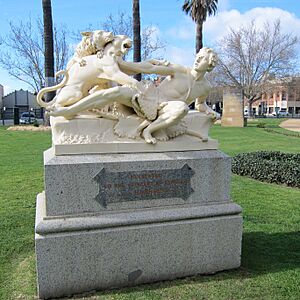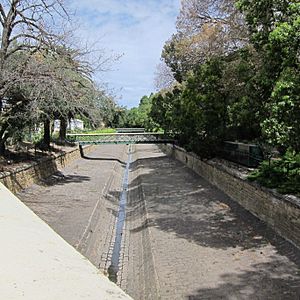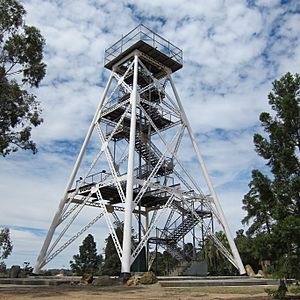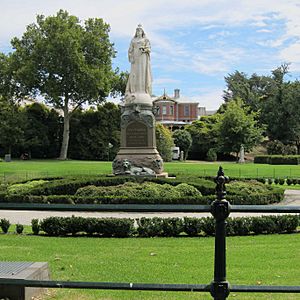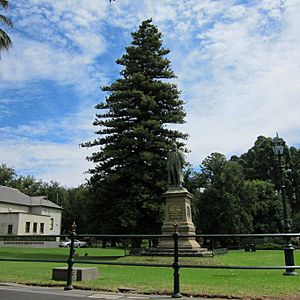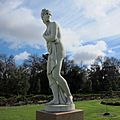Rosalind Park facts for kids
Quick facts for kids Rosalind Park |
|
|---|---|
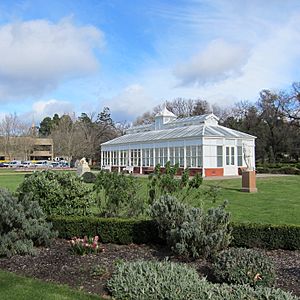
View of the conservatory and gardens
|
|
| Type | Public Park |
| Location | Bendigo, Victoria |
| Area | 59 acres (24 ha) |
| Owned by | City of Greater Bendigo |
Rosalind Park is a beautiful park located in Bendigo, Victoria, Australia. Before European settlers arrived, this area was a grassy woodland. A creek, now called Bendigo Creek, flowed through it, mostly as a series of pools. This spot was very important for the Dja Dja Wrung people. They lived in this dry part of central Victoria and used the creek for food and water.
In the 1850s, something big happened: gold was found! This discovery completely changed the area that is now Rosalind Park. Bendigo became one of the richest gold mining places in the world. Between 1850 and 1900, more gold was found here than anywhere else. Even today, it's still the seventh richest goldfield in the world! The landscape was full of mining equipment, shafts, and piles of waste from the mines.
In 1852, the area was officially named a "Government Camp." This camp's boundaries are still roughly the same as the park's today. The Government Camp was about 66 acres. It had police buildings, a jail, a courthouse (which is still used!), a gold office, and other government buildings.
In 1856, a local Gold Commissioner named Joseph Panton first suggested turning the camp into a park. But it wasn't until 1861 that 59 acres were officially set aside for the park. This land was given to the Sandhurst Borough Council, which is now the City of Greater Bendigo. The first park gardener started work in 1870. He created the basic design of Rosalind Park, which you can still see today.
Contents
Park Features and History
Rosalind Park is surrounded by several streets, including View Street and Pall Mall. It shares space with other important places. These include the Queen Elizabeth Oval, Bendigo Senior Secondary College, the Courthouse, and the old Bendigo Post Office (now a tourist center). Camp Hill Primary School and the Ulumburra Theatre (once a jail) are also nearby.
The park is historically important because it was one of the biggest government camps during Victoria's gold rush. It's also a great example of a public park from the late 1800s. The area is also important for archaeology, meaning it holds clues about the past. You can also see amazing old buildings and plants here. The cast-iron conservatory in the park is the only one of its kind from the 1800s still standing in a public park in Victoria.
Amazing Trees and Plants
Rosalind Park has many special trees and plants. Some are even listed on heritage registers because they are so important. Look out for these unique trees:
- The Bunya-Bunya Pine
- The Hoop Pine
- The South African Yellowwood
- River Red Gums
- Canary Island Pines
- Cedar trees
- The California Bay (also called the headache tree, and the only one in Victoria!)
- A Crows Ash (one of only three in Victoria)
- Queensland Kauri trees
- Many types of elm and oak trees
You can also find the Chilean Wine Palm here. This tree is rare in its home country of Chile, but it grows well in Rosalind Park, even though the climate isn't perfect for it.
Conservatory Gardens
Before 1987, this area was actually a rubbish tip! Now, it's a beautiful garden with a fancy cast-iron fence. You'll see some amazing exotic palms here, like the Washington Fan Palm. These were planted in the late 1800s. The garden also has many statues.
The Conservatory Gardens are used to show off different flowers all year round. You can see them in the garden beds and inside the conservatory building.
Bendigo Creek Area
When settlers first arrived, Bendigo Creek was the only easy source of water. But soon, it wasn't enough for the growing population. The creek you see today is here because of a "competition" held in 1862. The goal was to find a way to bring water from the Coliban River to the goldfields. This "artificial creek" was finished in 1877 and is still used today. However, Bendigo now has other water sources.
The part of Bendigo Creek that flows through Rosalind Park got its current look in the late 1800s. Three cast-iron bridges, built in 1882, cross the creek. The creek banks are lined with hand-laid flagstone and sandstone, topped with granite. It shows the amazing building skills from that time.
Fernery
The fernery was first suggested in 1879. It's special because it's the last fernery from that time still on public land. It was built by filling in an old billabong (a waterhole). However, some large trees, like River Red Gums, were kept. They provide shade and shelter for the ferns planted underneath.
Poppet Head Lookout
The lookout is at the top of Camp Hill. It used to be a poppet head from the Garden Gully United mine, which was one of Bendigo's richest gold mines. It was moved to its current spot in 1931. Before the poppet head was there, a flag was flown at the top of Camp Hill to signal that the mail had arrived. Back then, Camp Hill had no trees, so the flag could be seen from all over town.
At the bottom of the poppet head lookout, you'll find the Bendigo Heritage Mosaic. It was finished in 1987 and designed by artist Maery Gabriel. Local volunteers helped to create it. The mosaic shows different parts of Bendigo's history. It's designed to be viewed from the lookout, looking down.
Cascades
Water features were very popular in gardens during the 1800s. In 1880, the "Cascades" were built in Rosalind Park. They were designed by a famous Bendigo architect named William Vahland. He got ideas from George Lansell, who had just returned from a trip to Europe. The cascades originally had statues and fountains, which might have worked around the 1880s. It's thought that the cascades didn't work very well because the pumps back then weren't strong enough. They fell into disrepair in the early 1900s and were mostly buried until they were partly fixed in 1997.
Queen Victoria Gardens
Across from the Alexandra Fountain are the Queen Victoria Gardens. These gardens are famous for a large statue of Queen Victoria, built in 1903. You'll also see a bust (a statue of just the head and shoulders) of Sir John Quick, who was one of the "fathers of federation" for Australia. The gardens also have many other special plants and garden features.
Lansell Gardens
This small garden has a large statue of George Lansell. He is holding a big piece of quartz in his hand. The words at the bottom of the statue say: "In appreciation of the indomitable courage and persistent enterprise of George Lansell in the development of Bendigo's gold resources. This memorial was erected by the citizens of Bendigo. 1823 – 1906".
George Lansell was one of the most famous and successful miners in the Bendigo area. He was known as the 'Quartz King'.
Future Plans for the Park
In 2014, the City of Greater Bendigo Council shared plans to make the park even better. They want to connect Rosalind Park with the Queen Elizabeth Oval, the Tom Flood Velodrome, the Chinese precinct, and other areas. The goal is to create one big, connected park space that can be used for many different things. Work on this new idea for the park hasn't started yet, and people in the community are still talking about it.
Images for kids


